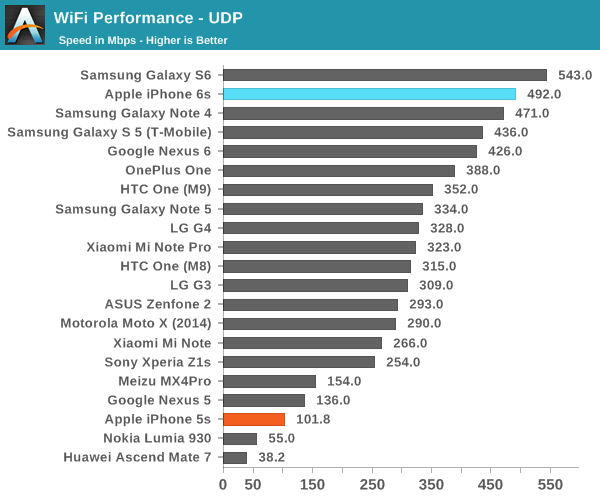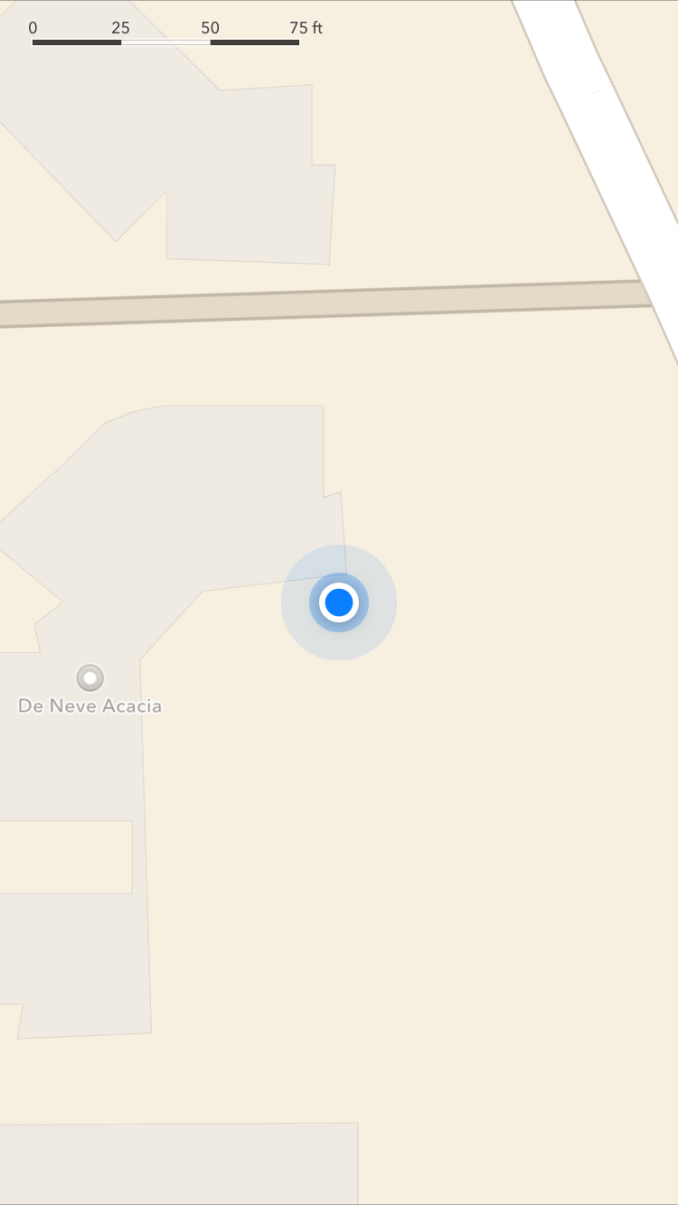The Apple iPhone 6s and iPhone 6s Plus Review
by Ryan Smith & Joshua Ho on November 2, 2015 8:00 AM EST- Posted in
- Smartphones
- Apple
- Mobile
- SoCs
- iPhone 6s
- iPhone 6s Plus
WiFi Performance
While cellular data is often the center of smartphone connectivity, it’s often the case that people rely on WiFi instead of cellular data for the bulk of their data transfers. As a result WiFi is a pretty important part of the overall smartphone experience. In the case of the iPhone 6s, the major change from the iPhone 6 is that rather than single stream 802.11ac, the iPhone 6s now has dual spatial stream 802.11ac. This increases the maximum physical link rate to 867 Mbps. There’s been some confusion over what’s used for the WiFi chipset, and as far as I can tell this is definitely a Broadcom solution, which is identified as BCM4350 in the system judging by the device ID. This chipset is shared with the Macbook, which is probably helpful for driver development. In order to test how well this performs, we use iperf2 in UDP mode to attempt to determine maximum practical bandwidth. It’s worth noting here that the iperf2 ports on iOS are still amazingly buggy though, so these results are no guarantee as far as I can tell.

Interestingly enough, for whatever reason the iPhone 6s holds a minor lead over most of the other devices in this test. I’m not sure what’s causing this, but in practice I found that WiFi on the iPhone 6s worked without any noticeable issues. Reception is noticeably improved when compared to the iPhone 6 due to the addition of a second spatial stream which means that throughput at the same distance is higher.
GNSS
Accurate location is often critical to a number of popular applications for smartphones like any kind of navigation or mapping application, which is going to be an incredibly painful experience if the GNSS system in the phone has poor sensitivity to the signals used in the various GNSS systems available today. Although I have no hard evidence to go on, given the use of a Qualcomm modem in this phone I strongly suspect that this phone is using Qualcomm's IZat location services. I would normally run some cursory testing here with a GPS test application, but because iOS offers no way to clear assistance data and location services are disabled if there is no prior connection to download assistance data, there's no way to do the usual cold lock testing.
A warm lock in which connection was immediately established to begin downloading assistance data achieved lock within 15 seconds, and in general I've never had issues with location services in the iPhone 6s in my time using it.
Misc
Over the course of the review, there are a lot of various bits and pieces that I learn about a phone that might be of interest, but aren’t necessarily examined in intense depth because of either limitations in our testing or the issue of interest isn’t significant enough to examine closely. For example, the fuel gauge appears to be a TI design win as there are references to a BQ27540 chip. The A9 SoC also contains a dedicated AES accelerator for things like full disk encryption and FairPlay DRM. The display backlight appears to use the TI LM3539 driver, but other evidence within the system suggests that this isn’t the only backlight driver for the display.
On the audio side of things, although I haven’t been able to do deep investigations into audio quality it appears in the system that the audio codec used is Cirrus Logic’s CS42L71 which also appears to be responsible for microphone input. However, instead of using an amplified on the audio codec a dedicated amp is used for the speaker, which appears to be a Cirrus Logic CS35L21. Subjectively, the speaker sounds pretty similar to the iPhone 6, but at the high end of the volume range it feels like volume was increased while also increasing distortion. Turning down the volume to a comparable level makes both sound pretty much the same.
More reading of the system files reveals some noticeable codenames like Stockholm which appears to be related to NFC and payments in some way. The fingerprint sensor is referred to as Mesa, and the authentication/secure element appears to be Sand Dollar. The charger chip is referred to either as SN2400 or Tigris. Some sort of accessory detection chip is referred to as TriStar2 or CBTL1610. The ambient light sensor is referred to as CT821 but I can’t find anything on what this is at all.











531 Comments
View All Comments
osxandwindows - Tuesday, November 3, 2015 - link
Ios problem other iPhones have it not mine tho.kmmatney - Tuesday, November 3, 2015 - link
I haven't done real tests, but overall I'd say my 6S plus has better audio that any other smartphone we've owned. So I've compared it against other iPhone and Android models, but I've never compared to the HTC M1. Nothing to complain about, for sure, onboard sound is clean and relatively loud when needed.mashuri - Wednesday, November 4, 2015 - link
Has their audio hardware changed in any notable way?mashuri - Wednesday, November 4, 2015 - link
BTW, no hissing or buzzing on my 6s+. Very clean sound on my headphones and earbuds.elpadrino27 - Tuesday, November 3, 2015 - link
I'm happy I bought the iPhone 6S Plus. Feels great after switching from the 5S. Just to let you guys know, in India, the iPhone 6S plus models are shipping with 10W power bricks in the box :)zeeBomb - Tuesday, November 3, 2015 - link
I heard of that...I guess India has more smartphone enthusiasts than here! But really, I hope apple can fix that in 2016.davidbressler - Tuesday, November 3, 2015 - link
Minor "correction" (I think).In the first table comparing the change from the 6 (both versions) to 6s (both versions) I think you left out the new front camera flash (the selfie flash). It's significant in that Apple created a new chip to drive turning the display into a flash.
David
metayoshi - Tuesday, November 3, 2015 - link
I'm surprised and very excited to hear that the iPhone 6s is using NVMe as their storage interface protocol. We're living in an exciting future.Turbofrog - Tuesday, November 3, 2015 - link
I fundamentally disagree with the technical assessment you guys have with respect to the camera. It's indefensible that Apple chose to use such a small sensor for their new camera given that the standard for flagship quality has moved forward since the iPhone 6 last year.I understand your argument for Z-height, but one could simply use the same physical focal length and accept the wider field of view. This is possible because the iPhone sensor possesses no actual technical advantages over it's competitors, it merely benefits from Apple's image processing expertise.
In essence, there is an iPhone sensor available to crop down to inside every single Galaxy S6, LG G4, or Lumia 950. With 12MP in 17.3mm^2, that's essentially the same pixel density that its 16MP or 20MP larger sensor competitors have. So if you don't like the wider field of view? Simply crop your image, and you will have the same pixel-level quality (absent processing) as you're getting from the iPhone for free.
And I would argue that given how much processing goes on behind the scenes to correct every single facet of a smartphones imaging chain, the geometric distortion associated with a wider lens, larger image circle, or faster aperture is really a moot point. There's probably a reason that you don't have access to the RAW files coming from an iPhone, and it's not because they look amazing. There are already dozens of lossy operations going on to correct distortion, remove chromatic aberration and colour casts, and lighten vignetting. It's not as if the iPhone's slower lens visibly demonstrates dramatically sharper corners or more detail than its competition, so again I don't understand why you are defending this decision.
TL;DR - the iPhone sensor and lens are technically behind the competition, a decision which only reduces image quality, and can only be realistically defended on the basis of cost-reduction measures.
JoshHo - Friday, November 6, 2015 - link
A wider field of view causes different optical compromises to be taken. In order to maintain acceptable MTF at the edges detail at the center of the photo is often compromised in response. Given the enormous issues I've seen with the Xperia Z3v with distortion, field curvature, and other aberrations I would need evidence to really believe this.